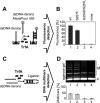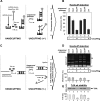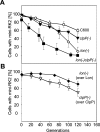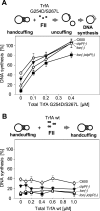Handcuffing reversal is facilitated by proteases and replication initiator monomers
- PMID: 28335002
- PMCID: PMC5397158
- DOI: 10.1093/nar/gkx166
Handcuffing reversal is facilitated by proteases and replication initiator monomers
Abstract
Specific nucleoprotein complexes are formed strictly to prevent over-initiation of DNA replication. An example of those is the so-called handcuff complex, in which two plasmid molecules are coupled together with plasmid-encoded replication initiation protein (Rep). In this work, we elucidate the mechanism of the handcuff complex disruption. In vitro tests, including dissociation progress analysis, demonstrate that the dimeric variants of plasmid RK2 replication initiation protein TrfA are involved in assembling the plasmid handcuff complex which, as we found, reveals high stability. Particular proteases, namely Lon and ClpAP, disrupt the handcuff by degrading TrfA, thus affecting plasmid stability. Moreover, our data demonstrate that TrfA monomers are able to dissociate handcuffed plasmid molecules. Those monomers displace TrfA molecules, which are involved in handcuff formation, and through interaction with the uncoupled plasmid replication origins they re-initiate DNA synthesis. We discuss the relevance of both Rep monomers and host proteases for plasmid maintenance under vegetative and stress conditions.
© The Author(s) 2017. Published by Oxford University Press on behalf of Nucleic Acids Research.
Figures








Similar articles
-
Opposing effects of DNA on proteolysis of a replication initiator.Nucleic Acids Res. 2012 Feb;40(3):1148-59. doi: 10.1093/nar/gkr813. Epub 2011 Oct 5. Nucleic Acids Res. 2012. PMID: 21976729 Free PMC article.
-
Conformation of a plasmid replication initiator protein affects its proteolysis by ClpXP system.Protein Sci. 2009 Mar;18(3):637-49. doi: 10.1002/pro.68. Protein Sci. 2009. PMID: 19241373 Free PMC article.
-
Plasmid replication initiator interactions with origin 13-mers and polymerase subunits contribute to strand-specific replisome assembly.Proc Natl Acad Sci U S A. 2015 Aug 4;112(31):E4188-96. doi: 10.1073/pnas.1504926112. Epub 2015 Jul 20. Proc Natl Acad Sci U S A. 2015. PMID: 26195759 Free PMC article.
-
Two replication initiators - one mechanism for replication origin opening?Plasmid. 2014 Nov;76:72-8. doi: 10.1016/j.plasmid.2014.10.003. Epub 2014 Oct 18. Plasmid. 2014. PMID: 25454070 Review.
-
Comparative genomics and functional roles of the ATP-dependent proteases Lon and Clp during cytosolic protein degradation.Res Microbiol. 2004 Nov;155(9):710-9. doi: 10.1016/j.resmic.2004.06.003. Res Microbiol. 2004. PMID: 15501647 Review.
Cited by
-
ClpC2 protects mycobacteria against a natural antibiotic targeting ClpC1-dependent protein degradation.Commun Biol. 2023 Mar 21;6(1):301. doi: 10.1038/s42003-023-04658-9. Commun Biol. 2023. PMID: 36944713 Free PMC article.
-
ClpAP protease is a universal factor that activates the parDE toxin-antitoxin system from a broad host range RK2 plasmid.Sci Rep. 2018 Oct 16;8(1):15287. doi: 10.1038/s41598-018-33726-y. Sci Rep. 2018. PMID: 30327496 Free PMC article.
-
Reconsidering plasmid maintenance factors for computational plasmid design.Comput Struct Biotechnol J. 2018 Dec 15;17:70-81. doi: 10.1016/j.csbj.2018.12.001. eCollection 2019. Comput Struct Biotechnol J. 2018. PMID: 30619542 Free PMC article. Review.
-
DNA and Polyphosphate in Directed Proteolysis for DNA Replication Control.Front Microbiol. 2020 Oct 2;11:585717. doi: 10.3389/fmicb.2020.585717. eCollection 2020. Front Microbiol. 2020. PMID: 33123115 Free PMC article. Review.
-
Mechanisms of Theta Plasmid Replication in Enterobacteria and Implications for Adaptation to Its Host.EcoSal Plus. 2020 Nov;9(1):10.1128/ecosalplus.ESP-0026-2019. doi: 10.1128/ecosalplus.ESP-0026-2019. EcoSal Plus. 2020. PMID: 33210586 Free PMC article. Review.
References
-
- Ingmer H., Fong E.L., Cohen S.N.. Monomer-dimer equilibrium of the pSC101 RepA protein. J. Mol. Biol. 1995; 250:309–314. - PubMed
-
- Kolatka K., Kubik S., Rajewska M., Konieczny I.. Replication and partitioning of the broad-host-range plasmid RK2. Plasmid. 2010; 64:119–134. - PubMed
-
- Chattoraj D.K. Control of plasmid DNA replication by iterons: no longer paradoxical. Mol. Microbiol. 2000; 37:467–476. - PubMed
MeSH terms
Substances
LinkOut - more resources
Full Text Sources
Other Literature Sources

